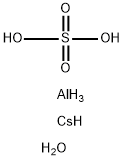Production Methods
The alkali metals and Al are present in pollucite in about the right proportions for the formation of alum. Hence, Clusius and Stern can follow the procedure. The mineral is decomposed with hydrochloric acid, and Cs is precipitated as a low-solubility alum by treatment with sulfuric acid. Thus, 0.5 kg of very finely pulverized (0.01 mm.) pollucite in one liter of 18% hydrochloric acid is evaporated to dryness on a water bath. This procedure is repeated three times, and each time the dry residue is extracted with one liter of HaO + 100 ml. of concentrated hydrochloric acid. This is followed by suction filtration on a filter cloth. The filtered extracts are combined and concentrated to one liter, and the silicic acid, which separates almost completely, is decanted. The alum is then gradually precipitated with 200 ml. of concentrated H3SO4. After cooling, about 545 g of crude yellowish alum is obtained. The mother liquor is practically free of Cs. The crystallization is repeated several times, dissolving 250 g of the alum in 2.5 liters of boiling water in a four-liter Erlenmeyer flask. On slow cooling (constant agitation, 10 hours), the alum again separates. The material obtained after six crystallizations shows no traces of other alkali metals. One way to ensure pure alum is to check the purity of the mother liquor from which it is precipitated.

